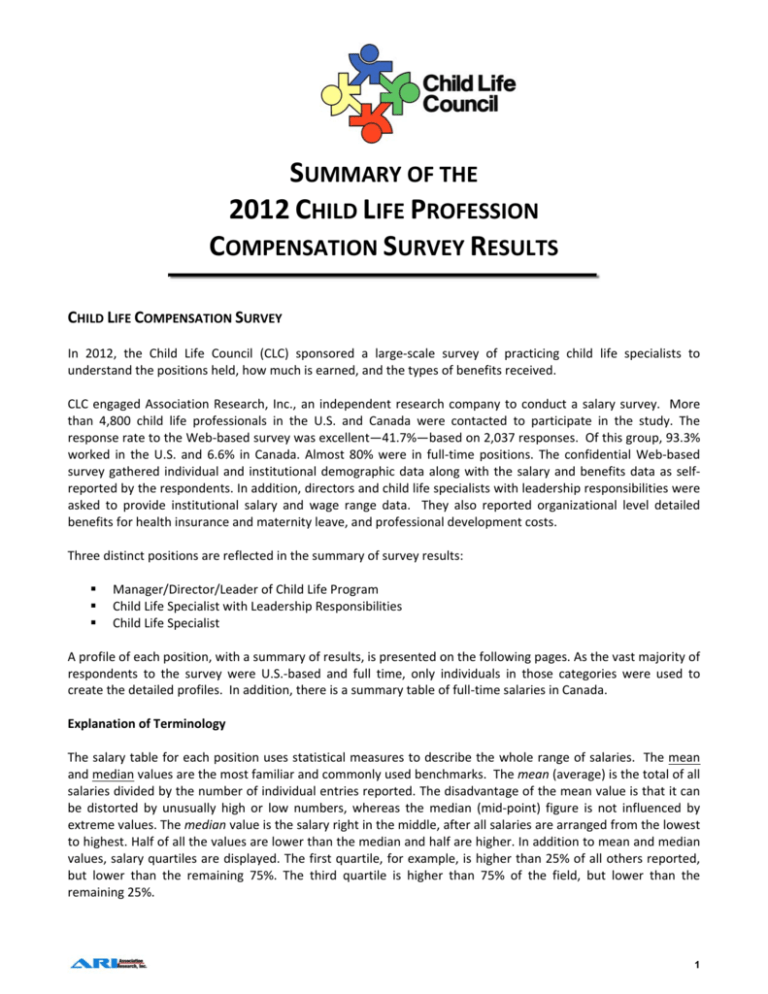Summary of the Salary Survey Results
advertisement

SUMMARY OF THE 2012 CHILD LIFE PROFESSION COMPENSATION SURVEY RESULTS CHILD LIFE COMPENSATION SURVEY In 2012, the Child Life Council (CLC) sponsored a large‐scale survey of practicing child life specialists to understand the positions held, how much is earned, and the types of benefits received. CLC engaged Association Research, Inc., an independent research company to conduct a salary survey. More than 4,800 child life professionals in the U.S. and Canada were contacted to participate in the study. The response rate to the Web‐based survey was excellent—41.7%—based on 2,037 responses. Of this group, 93.3% worked in the U.S. and 6.6% in Canada. Almost 80% were in full‐time positions. The confidential Web‐based survey gathered individual and institutional demographic data along with the salary and benefits data as self‐ reported by the respondents. In addition, directors and child life specialists with leadership responsibilities were asked to provide institutional salary and wage range data. They also reported organizational level detailed benefits for health insurance and maternity leave, and professional development costs. Three distinct positions are reflected in the summary of survey results: Manager/Director/Leader of Child Life Program Child Life Specialist with Leadership Responsibilities Child Life Specialist A profile of each position, with a summary of results, is presented on the following pages. As the vast majority of respondents to the survey were U.S.‐based and full time, only individuals in those categories were used to create the detailed profiles. In addition, there is a summary table of full‐time salaries in Canada. Explanation of Terminology The salary table for each position uses statistical measures to describe the whole range of salaries. The mean and median values are the most familiar and commonly used benchmarks. The mean (average) is the total of all salaries divided by the number of individual entries reported. The disadvantage of the mean value is that it can be distorted by unusually high or low numbers, whereas the median (mid‐point) figure is not influenced by extreme values. The median value is the salary right in the middle, after all salaries are arranged from the lowest to highest. Half of all the values are lower than the median and half are higher. In addition to mean and median values, salary quartiles are displayed. The first quartile, for example, is higher than 25% of all others reported, but lower than the remaining 75%. The third quartile is higher than 75% of the field, but lower than the remaining 25%. 1 Each salary table also shows how salary levels vary by education, location, and experience. The crosstab for education displays the difference between individuals with a Bachelor’s and those with a Master’s degree. For location, U.S. Census Districts are used. A final table summarizing benefits offered by job position is included. Executive Report on Child Life Salaries and Compensation Available Detailed statistical tables and analysis are available in the 2012 Child Life Compensation Study, published by CLC. This inclusive report provides an analysis of salaries and benefits for part‐time employees, and contains a separate section covering salaries and benefits for respondents working in Canada. The detailed Salary tables have additional breakouts for gender, credentials, community size, institution or organization type, number of pediatric beds, as well as number of people supervised. To obtain the Compensation Study, please visit www.childlife.org. Child Life Council, Inc. 11821 Parklawn Drive, Suite 310 Rockville, MD 20852 www.childlife.org 2 MANAGER/DIRECTOR/LEADER OF CHILD LIFE PROGRAM Position Description: This individual should be designated as the head of the child life program with responsibilities that can include: Managing the department budget, salaries, and staffing Evaluating staff, department needs, and overall contributions to organization Advocating for needs of department and organization Authorizing and encouraging fundraising and special events for the program and organization Demographic Highlights ‐ United States, Full‐Time: Average Age Master’s Degree as Highest Education Certified Child Life Specialist (CCLS) Average Years as Child Life Specialist Average Number of Pediatric Hospital Beds Average Number of People Supervised Children’s Hospital within Hospital Children’s Hospital (freestanding) Metro Area with 1 Million Population or More 44 60% 96% 17 169 13 42% 34% 49% Annual Salary as of September 1, 2012 Manager/Director/Leader of Child Life Program United States Full-Time All Full-time Respondents Highest Education Bachelor's Degree Master's Degree New England Middle Atlantic South Atlantic East South Central US Census Districts West South Central East North Central West North Central Mountain Pacific Years as Child Life Professional Less than 4 years 4 - 9 years 9 years or more Number of Respondents 159 59 95 7 39 25 10 21 23 9 10 15 5 24 117 Annual Salary as of September 1, 2012 First Quartile Median 25% 50% Mean 71,487 56,000 69,311 64,076 50,898 61,000 76,053 59,000 72,800 71,218 60,000 71,427 77,061 56,000 71,739 60,639 48,477 61,000 66,216 50,742 63,575 71,305 57,060 68,640 73,131 50,359 69,311 65,183 55,856 63,876 67,439 55,112 66,500 82,931 73,689 80,000 44,594 37,484 48,000 54,501 45,828 50,449 75,077 60,000 72,000 2011-2012 Salary Change Third Quartile 75% 83,928 73,689 90,000 79,000 90,000 72,489 78,875 87,932 89,315 77,500 78,357 93,642 50,000 57,738 85,899 Median 2.3% 2.3% 2.5% 3.2% 1.8% 2.5% 2.2% 2.6% 2.9% 2.0% 4.8% 4.1% 11.5% 2.4% 2.2% 3 CHILD LIFE SPECIALIST WITH LEADERSHIP RESPONSIBILITIES Position Description: This individual should meet the same requirements as a child life specialist with the addition of administrative/supervisory responsibilities. This description does not include management of volunteers or interns; only supervision of paid staff is included. Responsibilities can include: Supervision/clinical supervision of department staff members Coordinating child life internship program Formal mentorship of junior child life specialists Grant writing and fund development responsibilities New program development Clinical education responsibilities Demographic Highlights ‐ United States, Full‐Time: Average Age 36 Bachelor’s Degree as Highest Education 52% Master’s Degree as Highest Education 47% Certified Child Life Specialist (CCLS) 99% Average Years as Child Life Specialist 11 Average Number of Pediatric Hospital Beds 187 Average Number of People Supervised 3 Children’s Hospital within Hospital 35% Children’s Hospital (freestanding) 43% Metro Area with 1 Million Population or More 40% Annual Salary as of September 1, 2012 Child Life Specialist with Leadership Responsibilities United States Full-Time All Full-time Respondents Highest Education Credentials Bachelor's Degree Master's Degree CCLS New England Middle Atlantic South Atlantic East South Central US Census Districts West South Central East North Central West North Central Mountain Pacific Less than 4 years Years as Child Life Professional 4 - 9 years 9 years or more Number of Respondents 331 173 155 328 26 68 58 7 36 44 34 19 39 43 133 151 Annual Salary as of September 1, 2012 First Median Quartile Mean 50% 25% 49,509 41,000 48,610 47,187 39,322 45,552 52,230 44,720 50,918 49,517 41,000 48,370 56,485 44,107 53,594 49,631 44,741 49,288 45,425 38,837 43,000 45,943 39,408 46,488 46,084 39,261 46,062 48,431 42,160 49,898 46,531 36,419 48,370 44,844 39,187 43,035 60,606 52,000 59,738 39,428 34,000 38,000 46,547 40,000 46,000 54,987 47,000 52,350 2011-2012 Salary Change Third Quartile 75% 55,000 52,858 58,000 55,000 63,834 54,060 50,250 49,641 52,375 53,000 51,393 50,000 67,400 42,432 52,000 60,778 Median 2.5% 2.6% 2.5% 2.6% 2.1% 2.1% 2.1% .3% 3.0% 2.9% 2.8% 2.6% 3.4% 4.5% 2.9% 2.2% 4 CHILD LIFE SPECIALIST Position Description: This individual typically has earned certification as a child life specialist. Minimal education requirements are at the bachelor’s degree level, along with successful completion of a child life internship. Responsibilities may include: Applying growth and development theory and practice to work with children and youth Applying evidence‐based practice concepts, including play, preparation and assessment Facilitating and evaluating daily interactions and interventions with patients and staff Managing unit‐based volunteers Organizing special events and community visits Managing support groups and other regularly scheduled events Demographic Highlights – United States, Full Time: Average Age Bachelor’s Degree as Highest Education Master’s Degree as Highest Education Certified Child Life Specialist (CCLS) Average Years as Child Life Specialist Average Number of Pediatric Hospital Beds Children’s Hospital within Hospital Children’s Hospital (freestanding) Metro Area with 1 Million Population or More 31 64% 34% 98% 6 208 35% 51% 39% Annual Salary as of September 1, 2012 Child Life Specialist Number of Respondents United States Full-Time All Full-time Respondents Bachelor's Degree Highest Education Master's Degree Other New England Middle Atlantic South Atlantic East South Central US Census Districts West South Central East North Central West North Central Mountain Pacific Years as Child Life Professional Less than 4 years 4 - 9 years 9 years or more Annual Salary as of September 1, 2012 First Median Quartile 50% 25% Mean 2011-2012 Salary Change Third Quartile 75% Median 823 42,720 36,754 41,184 47,157 2.5% 526 282 11 53 141 144 43 120 130 60 69 61 352 308 151 41,334 44,985 46,544 42,775 44,475 39,265 37,162 41,311 41,278 43,155 43,611 55,164 39,046 43,321 50,250 35,825 38,505 41,978 39,427 40,000 34,948 33,550 35,984 36,475 37,519 37,315 49,960 34,469 38,090 44,217 40,000 44,000 44,429 42,848 44,070 37,991 36,000 40,000 40,386 41,000 41,974 52,500 38,000 42,147 49,920 45,770 50,000 46,592 46,296 48,000 43,378 39,832 45,000 45,000 51,125 48,263 60,216 43,000 48,000 55,575 2.5% 2.5% 2.3% 1.9% 2.0% 2.9% 4.4% 2.2% 2.7% 2.1% 2.3% 3.0% 2.5% 2.6% 2.1% 5 Summary of Benefits Eligible for by Current Position United States Full-Time Annual Bonus Childcare on site Childcare allowance Flexible Spending Plan PTO or Traditional Leave Employer Contribution to Retirement Plan Dental Vision Care Group Life Insurance Health Club Membership Long-Term Care Long-Term Disability Short-Term Disability Eldercare Benefits Tuition Reimbursement Professional Association Dues Reimbursement Manager/ Director/ Leader of Child Life Program Number of Respondents Percent 48.4% 77 23.9% 38 11.9% 19 76.7% 122 87.4% 139 81.1% 129 88.1% 140 86.8% 138 84.9% 135 40.9% 65 56.0% 89 79.9% 127 83.6% 133 22.6% 36 75.5% 120 30.2% 48 Child Life Specialist with Leadership Responsibilities Number of ResponPercent dents 35.6% 118 19.3% 64 13.3% 44 78.9% 261 87.9% 291 81.0% 268 87.9% 291 83.7% 277 81.9% 271 39.3% 130 58.0% 192 79.8% 264 81.3% 269 24.8% 82 77.3% 256 21.1% Child Life Specialist Number of ResponPercent dents 42.9% 353 20.7% 170 15.1% 124 84.0% 691 98.5% 811 92.8% 764 97.8% 805 94.2% 775 89.3% 735 45.1% 371 60.8% 500 86.9% 715 90.2% 742 27.9% 230 85.8% 706 70 25.2% 207 Salary Highlights – Canada, Full Time: Annual Salary by Job Description - Full-Time Canada Number of Respondents Job Position Manager/Director/Leader of Child Life Program Child Life Specialist with Leadership Responsibilities Child Life Specialist Annual Salary as of September 1, 2012 First Quartile Median 25% 50% Mean 2011-2012 Salary Change Third Quartile 75% Median 6 72,676 56,960 74,305 89,042 2.2% 15 62,312 57,525 61,838 67,236 3.2% 46 62,038 56,946 63,700 65,933 2.1% Annual Salary by Province and Job Description - Full-Time Canada Number of Respondents Child Life Specialist with Leadership Responsibilities Province Child Life Specialist Province Job Position Annual Salary as of September 1, 2012 First Quartile Median 25% 50% Mean 2011-2012 Salary Change Third Quartile 75% Median Ontario 8 61,141 55,631 61,919 66,495 1.0% Alberta 5 79,597 72,288 80,499 86,454 6.8% 8 63,084 61,225 64,616 65,978 .0% 26 58,313 54,425 60,206 64,625 .7% British Columbia Ontario Note: Canadian compensation is presented in Canadian dollars. 6








